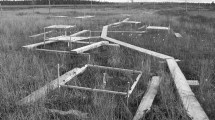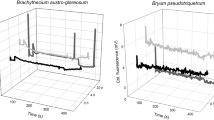Abstract
The effect of low temperatures and freeze-thaw stress on photosynthetic carbon exchange in an Antarctic population of the turf-forming moss species Polytrichum alpestre Hoppe was investigated using infra-red gas analysis. Photosynthetic recovery from freezing was found to depend on the absolute depth of low temperature experienced. Repeated freeze-thaw cycles caused a greater reduction in gross photosynthesis than constant freezing over the same period of time suggesting that the freeze-thaw event itself, and not just cold temperatures, causes damage. The frequency of freeze-thaw events was significant: freeze-thaw cycles every 12 h inflicted more damage than freezethaw cycles every 24 or 48 h. Most damage occurred during the first cycle; relatively little was recorded during subsequent cycles. At +10°C, gross CO2 flux was directly proportional to moss water content between 0.3 and 3.5 g·g−1 dry mass. Moss samples with a low water content withstood freeze-thaw cycles to -5, -10 and-20°C better than samples with a high water content indicating that desiccation in the field may improve survival at low temperatures. Microclimate data for field populations of Polytrichum alpestre at Signy Island suggest that sub-zero temperatures and freeze-thaw stress may act as limiting factors on the species' distribution and viability, particularly when the insulating effect of snow cover is small.
Similar content being viewed by others
References
Baker JH (1970) Yeasts, moulds and bacteria from an acid peat on Signy Island. In: Holdgate MW (ed) Antarctic Ecology. Academic Press, London, pp 717–722
Burke MJ, Gusta LV, Quamme HA, Weiser CJ, Li PH (1976) Freezing and injury in plants. A Rev Pl Physiol 27:507–528
Collins NJ (1976) Growth and population dynamics of the moss Polytrichum alpestre in the maritime Antarctic. Oikos 27:389–401
Collins NJ (1977) The growth of mosses in two contrasting communities in the maritime Antarctic: measurement and prediction of net annual production. In: Llano GA (ed) Adaptations within Antarctic Ecosystems. Gulf Publishing Co, Houston, pp 921–933
Collins NJ, Baker JH, Tilbrook PJ (1975) Signy Island, Maritime Antarctic. In: Roswall T, Heal OW (eds) Structure and function of tundra ecosystems. Ecol Bull (Stockholm), vol 20, pp 345–374
Davis RC (1981) Structure and function of two Antarctic terrestrial moss communities. Ecol Monogr 51:125–143
Davis RC (1983) Prediction of net primary production in two Antarctic mosses by two models of net CO2 fixation. Br Antarct Surv Bull 59:47–61
Davis RC, Harrisson PM (1982) Prediction of photosynthesis in maritime Antarctic mosses. CNFRA 51:241–247
Dilks TJK, Proctor MCF (1975) Comparative experiments on temperature responses in bryophytes: assimilation, respiration and freezing damage. J Bryol 8:317–336
Dilks TJK, Proctor MCF (1976) Effects of intermittent desiccation on bryophytes. J Bryol 9:249–264
Dirksen A (1964) Vergleichende Untersuchungen zur Frost-, Hitze- und Austrocknungsresistenz einheimischer Laub- und Lebermoose unter besonderer Berücksichtigung jahreszeitlicher Veränderungen. Dissertation, University of Göttingen.
Edwards JA, Smith RIL (1988) Photosynthesis and respiration of Colobanthus quitensis and Deschampsia antarctica from the maritime Antarctic. Br Antarct Surv Bull 81:43–63
Gannutz TP (1970) Photosynthesis and respiration of plants in the Antarctic Peninsula area. Antarct Jl US 5:49–51
Geiger R (1965) The climate near the ground. Harvard University Press, Cambridge, Mass, 611 pp
Gimingham CH, Smith RIL (1970) Bryophyte and lichen communities in the maritime Antarctic. In: Holdgate MW (ed) Antarctic Ecology. Academic Press, London, pp 752–785
Greene SW, Longton RE (1970) The effects of climate on Antarctic plants. In: Holdgate MW (ed) Antarctic Ecology. Academic Press, London, pp 786–800
Greenfield L (1988) Soil biological and biochemical investigations on Deception and Signy Islands. Br Antarct Surv Bull 81:75–76
Harrisson PM, Rothery P (1988) Net CO2 exchange in relation to thallus moisture and temperature in two fruticose lichens Usnea antarctica and Usnea aurantiaco-atra from the maritime Antarctic. Polarforschung 58:171–179
Harrisson PM, Walton DWH, Rothery P (1989) The effects of temperature and moisture on CO2 uptake and total resistance to water loss in the Antarctic foliose lichen Umbilicaria antarctica. New Phytol 111:673–682
Hicklenton PR, Oechel WC (1977) The influence of light intensity and temperature on the field carbon dioxide exchange in Dicranum fuscescens in the subarctic. Arct alp Res 9:407–419
Kallio P, Heinonen S (1971) Influence of short-term low temperature on net photosynthesis in some subarctic lichens. Rep Kevo Subarct Res Stat 8:63–72
Kallio P, Kärenlampi L (1975) Photosynthetic activity of multicellular lower plants (mosses and lichens). In: Cooper JP (ed) Photosynthesis and productivity in different environments. Cambridge University Press, Cambridge, pp 393–423
Kappen L (1964) Untersuchungen über den Jahreslauf der Frost-, Hitze- und Austrocknungsresistenz von Sporophyten einheimischer Polypodiaceen (Filicinae). Flora 155:123–166
Kappen L (1989) Field measurements of carbon dioxides exchange of the Antarctic lichen Usnea sphacelata in the frozen state. Antarct Sci 1:31–34
Kappen L, Smith RIL, Meyer M (1989) Carbon dioxide exchange of two ecodemes of Schistidium antarctici in continental Antarctica. Polar Biol 9:415–422
Lamb IM (1970) Antarctic terrestrial plants and their ecology. In: Holdgate MW (ed) Antarctic Ecology. Academic Press, London, pp 731–751
Larson DW (1978) Patterns of lichen photosynthesis and respiration following prolonged frozen storage. Can J Bot 56:2119–2123
Lange OL (1962) Die photosynthese der flechten bei tiefen temperaturen und nach frostperioden. Ber Dtsch Bot Ges 75:351–352
Lange OL, Kappen L (1972) Photosynthesis of lichens from Antarctica. In: Llano GA (ed) Antarctic Terrestrial Biology. Antarctic Research Series, 20, American Geophysical Union, Washington DC, pp 83–95
Levitt J (1980) Response of plants to environmental stresses, (second edition). Academic Press, London
Llano GA (1956) Botanical research essential to a knowledge of Antarctica. In: Crary AP, Gould LM, Hulbert EO, Odishaw H, Smith WE (eds) Antarctica in the International Geophysical Year. Geophysical Monograph No. 1, American Geophysical Union of the National Academy of Sciences, Washington, pp 124–133
Longton RE (1967) Vegetation in the maritime Antarctic. Phil Trans R Soc Lond B 252:213–235
Longton RE (1970) Growth and productivity of the moss Polytrichum alpestre Hoppe in Antarctic regions: In: Holdgate MW (ed) Antarctic Ecology. Academic Press, London, pp 818–837
Mazur P (1969) Freezing injury in plants. A Rev Pl Physiol 20:419–448
Proctor MCF (1972) An experiment on intermittent desiccation with Anomodon viticulosus (Hedw.) Hook & Taylor. J Bryol 7:181–186
Proctor MCF (1982) Physiological ecology: water relations, light and temperature responses, carbon balance. In: Smith AJE (ed) Bryophyte Ecology. Chapman & Hall, London, pp 333–382
Proctor MCF (1990) The physiological basis of bryophyte production. Bot J Linn Soc 104:61–77
Riedmüller-Schölm HE (1974) The temperature resistance of Alaskan plants from the continental boreal zone. Flora 163:230–250
Sakai A, Ōtsuka K (1970) Freezing resistance of alpine plants. Ecology 51:665–671
Schonbeck MW, Bewley JD (1981a) Responses of the moss Tortula ruralis to desiccation treatments. I. Effects of minimum water content and rates of dehydration and rehydration. Can J Bot 59:2698–2706
Schonbeck MW, Bewley JD (1981b) Responses of the moss Tortula ruralis to desiccation treatments. II. Variations in desiccation tolerance. Can J Bot 59:2707–2712
Šesták Z, Čatsky J, Jarvis PG (1971) Plant Photosynthetic Production — Manual of Methods. Junk, The Hague, 818 pp
Siple PA (1938) The second Byrd Antarctic expedition — botany. I. Ecology and geographical distribution. Ann Mo bot Gdn 25:467–515
Smith RIL (1972) Vegetation of the South Orkney Islands with particular reference to Signy Island. Br Antarct Surv Sci Rep 68, 133 pp
Smith RIL (1982) Growth and production in South Georgia bryophytes. CNFRA 51:229–239
Smith RIL (1990) Signy Island as a paradigm of biological and environmental change in Antarctic terrestrial ecosystems. In: Kerry KR, Hempel G (eds) Antarctic Ecosystems — Ecological Change and Conservation. Springer-Verlag, Berlin, pp 32–49
Smith RIL, Poncet S (1987) Deschampsia antarctica and Colobanthus quitensis in the Terra Firma Islands. Br Antarct Surv Bull 74:31–35
Steponkus PL (1984) Role of the plasma membrane in freezing injury and cold acclimation. A Rev Pl Physiol 35:543–693
Warren Wilson J (1957) Observations on the temperature of Arctic plants and their environments. J Ecol 45:499–531
Author information
Authors and Affiliations
Rights and permissions
About this article
Cite this article
Kennedy, A.D. Photosynthetic response of the Antarctic moss Polytrichum alpestre Hoppe to low temperatures and freeze-thaw stress. Polar Biol 13, 271–279 (1993). https://doi.org/10.1007/BF00238763
Received:
Accepted:
Issue Date:
DOI: https://doi.org/10.1007/BF00238763




